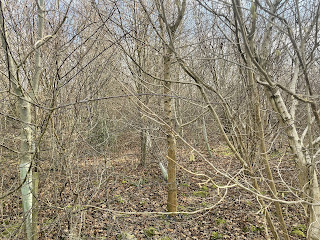Current work is all focussed on the coppicing. Removal of the underwood makes a huge difference to the look and feel of the wood. This is what the wood looks like before coppicing:
Some of the larger trees need to be cut - removing the birch and pollarding the willow. As they are close together the trees don’t fall, so the winch is pretty essential to safely pull the butt of the tree so it can come to the ground to be cut and stacked. In this photo the hadn't winch (in the foreground) has a cable running to the right to a winch pulley (also called a diverter pulley, snatch pulley, snatch block or pulley block) attached to a tree with the green strop. This pulley bends the cable so that the tree can be pulled in the bet direction. The tree that has been pulled is lying on the ground top left, with a mound of earth in front of the butt which has been created as it is pulled along:
I am starting new brush piles in next year’s compartment so that I can plant bulbs in the new compartment this autumn without covering when next winters cutting starts. So these sequence in each of the 7 compartments of the wood is:
1) In winter 1: start the brush heaps using the cuttings from the neighbouring compartment.
2) In autumn: plant bulbs (such as bluebell, wild garlic and wood anemone) avoiding the brush piles
3) In winter 2: coppice the compartment - putting cuttings on the already located brush heaps so you know that you are avoiding your newly planted bulbs.
4) In spring: as bulbs come up for the first time there is lots of light for them in the newly cut compartment.
I have 3 or 4 brush heaps for each half acre compartment. At the bottom of the heap I have put a pile of the large logs that are unstable for splitting (because they had branches coming off so have 'knots' in the wood). I hope that this will make a very nice habitat for amphibians:
The traditional method of woodland management involves use of the underwood - which had many uses in the past (wattles, posts, charcoal, firewood, stakes, pales, faggots, fodder, bark for tanning and many, many more). Today I only use it for firewood. The smaller wood is cut into 'cord wood' - traditionally 4 foot lengths, which I will cut into 4 pieces on a bench circular saw when coppicing has finished in the spring. The larger pieces have been cut into lengths with the chain saw - each about a foot long. Of course the wood does not from nicely in these dimensions so in practice length is variable around these dimensions:









